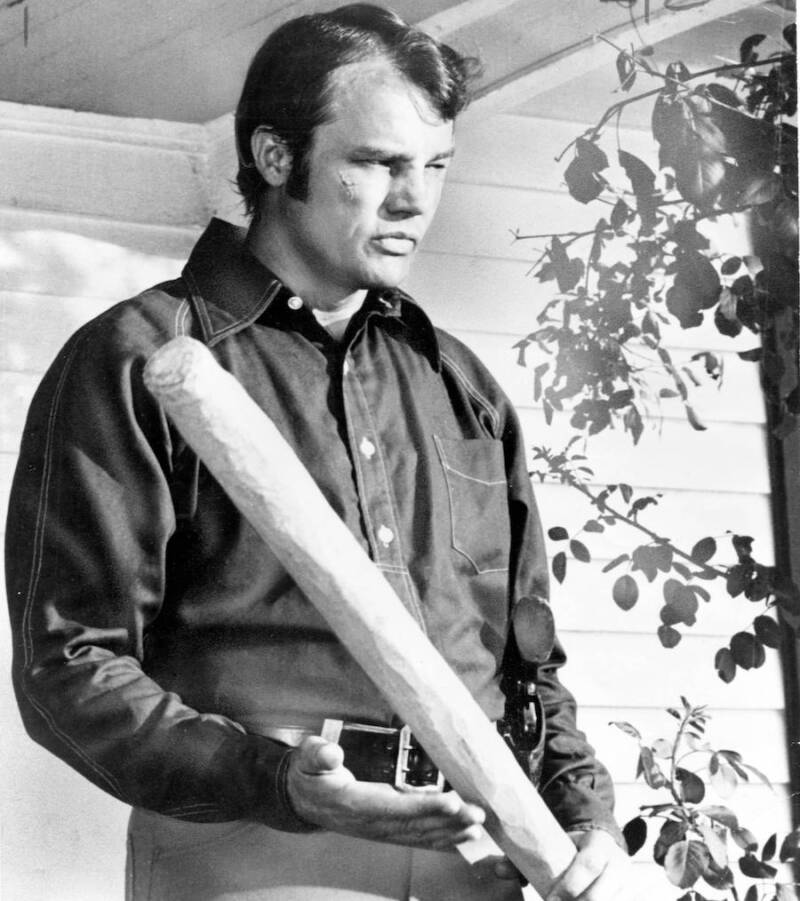From battling the Dixie Mafia and the State Line Mob to avenging his wife's death, Buford Pusser left an astonishing mark on American history before dying in a mysterious car crash — but later evidence shows he may have killed his wife himself.
Just before dawn on August 12, 1967, McNairy County Sheriff Buford Pusser received a call about a disturbance on a side road near Adamsville, Tennessee. Though it was early in the day, his wife Pauline decided to accompany him during his investigation.
As they drove through the small town toward the site of the reported disturbance, a second car eventually pulled up alongside theirs.
Suddenly, the occupants opened fire on the Pussers’ car. The sheriff managed to make it out wounded, but alive, with a severely injured jaw. His wife, however, wasn’t as lucky. She was dead in the passenger seat.

Buford Pusser’s life story inspired the 1973 movie Walking Tall.
The second car sped off and Pusser was left for dead. Instead, he was discovered and quickly taken to the hospital. It took him 18 days and several surgeries to physically recover, but he ultimately pulled through.
And as he returned home with his mangled jaw, he had only one thing on his mind: revenge. Pusser vowed then that before he died, he would bring everyone who killed his wife to justice — if it was the last thing he ever did.
This is the true story of Buford Pusser that inspired the film Walking Tall — and why subsequent evidence suggests the oft-repeated tale isn’t true, and the he actually killed his wife himself.
Who Was Buford Pusser?
Buford Pusser was born on December 12, 1937, in McNairy County, Tennessee. The son of Helen and Carl Pusser — the police chief of Adamsville, Tennessee — Buford was large and tough, even from a young age.
A natural athlete who quickly grew to be 6’6″ tall, he played on both the football and basketball teams in high school. He later joined the U.S. Marines, but he was soon discharged due to his asthma.
Eventually, in 1957, Pusser moved to Chicago and entered the local wrestling scene in the Windy City. Because of his massive size — and equally massive strength — he earned himself the nickname “Buford the Bull.” But a nickname wasn’t the only thing that Pusser found in Chicago.

FacebookBuford Pusser’s wife Pauline Pusser, who was killed on August 12, 1967.
It was there that he met a woman named Pauline Mullins, who he would soon marry. The two became husband and wife on December 5, 1959. Shortly thereafter, they returned to Pusser’s hometown of Adamsville, Tennessee, where he became the youngest sheriff in Tennessee’s history.
Buford Pusser’s Rise Through The Ranks
Though he was just 25 years old when he returned to Adamsville, the strong, no-nonsense Buford Pusser was soon elected chief of police and constable, a position that he would hold for about two years.
But then, in 1964, a car accident took the life of McNairy County Sheriff James Dickey. It was August 1st, and Dickey was on his way back to the station after, somewhat ironically, investigating another vehicle crash.
Dickey, a U.S. Army World War II veteran, was driving near the Mississippi-Tennessee state line when the front right tire on his vehicle suddenly blew out. Having lost control of his car, he veered off the edge of the road, tumbled down an embankment, and crashed into a wooded area.
In hindsight, it was something of an omen.
Pusser was soon elected to fill Dickey’s shoes. At 27 years old, Pusser had just become the youngest sheriff in the state’s history.
He quickly threw himself into his work, turning his attention to fighting the Dixie Mafia and the State Line Mob, two organized crime groups that operated on the border between Tennessee and Mississippi and made thousands of dollars off of the illegal sale of moonshine. These groups were also involved in illegal gambling, prostitution, robbery, and murder.

Entertainment Pictures/Alamy Stock PhotoBuford Pusser’s wild experiences as McNairy County Sheriff inspired the 1973 movie Walking Tall, which starred Joe Don Baker (pictured) as Pusser and became a cult classic.
As dramatized in Walking Tall, Pusser made enemies while going up against these groups — and seemed unfazed by it. According to The New York Times, Pusser made a point to personally destroy illegal gambling equipment with a pick-axe. And there was never any question about who was behind these rogue punishments — as Pusser was virtually the only member of law enforcement focusing on organized crime in this region at the time.
Not long after his election, in November 1964, Pusser was stabbed seven times by gang members who had evidently perceived him as a threat. He survived, but that was far from the only attempt on his life.
In the midst of his jaw-dropping crusade against criminal organizations — he shut down 87 whiskey stills in 1965 alone — he was shot eight times. According to the Buford Pusser Museum, he also fended off physical attacks, once fighting off six men at the same time (ultimately sending three to the hospital and three to jail). At one point, he was even run over by a car.
But the most devastating assassination attempt came in August 1967.
The Brutal Murder Of Pauline Pusser And The Shocking Aftermath
As the classic version of the story goes, it was around 4:30 a.m. on August 12, 1967 that Buford Pusser received a call informing him that there was a disturbance near the state line. Despite the early hour, Buford’s wife Pauline insisted on riding along with her husband as he investigated the report. He agreed, and they soon took off in their car.
As they approached New Hope Road, a car suddenly pulled up alongside them — and a barrage of bullets assailed the Pussers’ vehicle. The initial shots had missed Buford, but they struck Pauline in the head. With few options, Pusser sped off down the road, trying to lose his attackers.
When it seemed like he had lost them, he tried to tend to Pauline’s wounds. But the second car soon reappeared, and bullets came flying toward the couple once more. Pauline’s head was struck again. This time, the attackers also hit their intended target, and Buford Pusser’s jaw was shot off.

FacebookA newspaper article from 1967, detailing the investigation into Pauline Pusser’s murder.
After the Pussers were assisted by first responders, it was clear that Pauline could not be saved, and her husband was in danger of meeting the same fate. Instead, Buford Pusser recovered after 18 days in the hospital, which included multiple reconstructive surgeries on his face. Still, he would carry scars for the rest of his days — both physical and emotional scars.
He quickly vowed revenge against his wife’s killers. After he was released from the hospital, he was able to name the four alleged assassins, most notably identifying Dixie Mafia leader Kirksey McCord Nix Jr. as the mastermind who had orchestrated the deadly ambush.
Pusser was never able to bring Nix, or any of the others, to trial, though Nix was sentenced to life in prison in 1972 for a separate case, the murder of the grocery executive Frank Corso. (Nix would later be charged with ordering two more murders behind bars, and he remains in prison to this day.)
Still, Pusser cracked down harder on crime than ever before, cementing himself as a folk hero in the process. And, one way or another, his wife’s other three alleged killers eventually paid the price for their lives of crime.

FacebookBuford Pusser was apparently pleased with his portrayal in the movie Walking Tall and even agreed to star in a sequel — just hours before his untimely death in 1974.
One of the accused hitmen, Carl Douglas “Towhead” White, was found fatally shot in Mississippi in 1969. Rumors quickly swirled that Pusser himself had hired an assassin to kill White, though this was never confirmed.
Not long after that, the last two alleged hitmen, George McGann and Gary McDaniel, were also found shot to death in Texas in 1970. Again, many believed that Pusser had orchestrated their deaths, but this was never definitively proven. His alleged revenge for his wife’s death — and the virtual one-man war that he waged against organized crime near his hometown — made him a widely revered figure in Tennessee and beyond.
“Buford was a legend,” Tina Jarrell, the curator of the Buford Pusser Home and Museum, explained to the local station WBBJ. “He was fighting against the mob, the state line mob and they were very evil, mean people, and he stood up to them and wouldn’t take a bribe, like everyone else had in the past and he just, he really made an impact on society.”
Pusser’s story came to an untimely end, however, on August 21, 1974, when he suddenly lost control of his Corvette near Adamsville. The vehicle then crashed into an embankment, and later burst into flames — an end eerily similar to the sheriff who preceded him. He was just 36 when he perished.
Though the crash is officially considered an accident, many of Pusser’s loved ones, including his daughter, believe he was murdered, as Nix had been able to order other murders from prison. However, these claims have never been investigated, and many questions about Pusser’s death may unfortunately remain unanswered. But one thing is clear: This folk hero left an extraordinary mark on Tennessee, and his life story will never be forgotten.
New Evidence Suggests That Buford Pusser May Have Killed His Wife Himself
In 2025, authorities in Tennessee announced a shocking revelation that shook the well-known story of Buford Pusser to its core. They claimed that they’ve uncovered a wealth of evidence that Pusser was the one who killed his wife.
A review of the case files and a subsequent investigation unearthed evidence that Pauline had suffered from domestic violence and that there were glaring inconsistencies in the original narrative.
The cranial trauma that Pauline suffered, for example, didn’t align with the scene in the car’s interior as depicted in the crime scene photos. Meanwhile, though Pusser claimed Pauline was shot inside the car, the blood spatter suggests she was shot outside of it.
Pusser’s own wounds suggest that he was shot at close range (and not from outside the vehicle, as he said) and that it was likely self-inflicted.
Perhaps the story of Buford Pusser is still far from over.
After reading about Buford Pusser and the true story of “Walking Tall,” learn the incredible true story of Hugh Glass that inspired “The Revenant.” Then, read about Frank Lucas, the real “American Gangster.”





